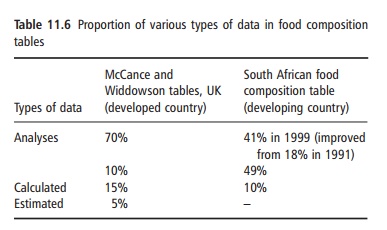Chapter: Introduction to Human Nutrition: Food Composition
Information required on sources of data in tables
Information required on sources of
data in tables
It is important to have information on the source of the data in
a food composition table to be able to check its appropriateness for the study
and to confirm its authenticity. The four major categories of sources of data
are:
●primary publications, e.g., peer-reviewed articles in scientific
literature
●secondary publications, e.g., reviews or published compilations with
compositional data
●unpublished reports ranging from analytical records to documents
prepared with limited circulation, e.g., confidential reports for clients or
internal use within a company
●unpublished analytical data that can be either spe-cifically
commissioned analyses for the generation of nutrient data or analytical data
that were not particularly generated for the purpose of generat-ing food
composition data.
Data in food composition tables may be original analytical
values, imputed, calculated, or borrowed. Original analytical values are those
taken from pub-lished literature or unpublished laboratory reports. Unpublished
reports may include original calculated values, such as protein values derived
by multiplying the nitrogen content by the required factor, energy values using
energy conversion factors for some con-stituents of food, and “logical” values,
such as the content of cholesterol in vegetable products, which can be assumed
to be zero. Imputed values are esti-mates derived from analytical values for a
similar food or another form of the same food. This category includes those
data derived by difference, such as moisture and, in some cases, carbohydrate
and values for chloride calculated from the sodium content. Cal-culated values
are those derived from recipes by cal-culation from the nutrient content of the
ingredients corrected by the application of preparation factors. Such factors
take into account losses or gain in weight of the food or of specific nutrients
during preparation of the food. Borrowed values are those derived from other
tables or databases without referring to the original source. When a value for
the content of a specific nutrient in a food is not included, there is a “–” or
“0” value and, when a table has no values for a particular nutrient, the value
is regarded as being “not included.” In some tables, e.g., the National
Nutrient Database for Standard Reference, SR, of the USDA, “0” value is a true
zero, meaning the particular nutri-ent was not detected by the analytical
method used; “–” indicates a missing value.
The proportion of the various types of data differs between
tables and for different nutrients (Table 11.6). Details on food tables can be
obtained from the Food and Agriculture Organization (http://www.fao

Related Topics